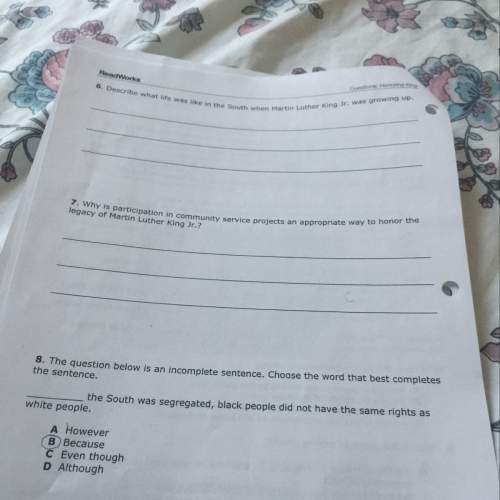
History, 30.10.2020 02:20 hailiemanuel3461
Please Answer by Sunday
On January 1, 1900, the United States had reason for optimism. Cities were bustling. Industry was booming. One factory owner, Andrew Carnegie, was about to sell his steel company and become the richest man in the world. Not bad for a weaver's son from Scotland. And if Carnegie could make it, why not anyone! However, if you peeled back the excitement and looked carefully, there was an underside. Not every-one in America was making it. In fact, in the absence of clear rules, not everyone in America had a chance of making it. Consider this: First, average earnings for American workers were less than $500 a year. In the South, the average for unskilled workers was closer to $300. And this was at a time when the poverty line for a family of six was $600 Second, hours were long. In 1900, the average work week was 60 hours. In the garment industry of New York City, it was 70 hours. Third, child labor was widespread. In 1900, 26% of boys between ten and fifteen years old were in the work force. For young girls the figure was 10%. Added to this, more than half of adult Americans were denied the right to vote. Women had never had the right, and most black men had lost the vote in the years after Reconstruction. Clearly, America had some work to do.
Define the following words:
1. Optimism
2. Bustling
3. Underside
4. Poverty Line
Use the reading to answer the questions:
1. Why did America have a reason for optimism in the 1900s?
2. How much were the average wages for an American in 1900?
3. What were the average wages for an American in the South in 1900?
4. How long was the average work week in 1900?
5. What percent (%) of boys between the ages of 10 and 15 worked?
Now, we have talked a lot about Progressive issues. You are going to look at some documents for certain issues. Be sure to answer the questions fully.
Document A:
Any fool can destroy trees. They cannot run away; and if they could, they would still be destroyed - chased and hunted down if fun or a dollar could be got out of their barks and hides It took more than three thousand years to make some of the trees in these western woods - trees that are still standing in perfect strength and beauty, waving and singing in the mighty forests of the Sierras. Through all the wonderful, eventful centuries since Christ's time - and long before that - God has cared for these trees, saved them from drought, disease, avalanches, and a thousand straining, leveling tempests and floods; but He cannot save them from fools - only Uncle Sam can do that.
QUESTIONS:
1. How long did it take to make trees?
2. Why do people cut down trees?
3. According to the author, why should these trees be protected?
4. What is the big issue this is addressing?
5. Is this still an issue today? Why or why not?
Document B
The boys working in the breaker are bent double, with little chance to relax; the air at times is dense with coal-dust, which penetrates so far into the passages of the lungs that for long periods after the boy leaves the breaker, he continues to cough up the black coal dust. Fingers are calloused and cut by the coal and slate, the noise and monotony are deadening While I was in the region, two breaker boys of 15 years ... fell or were carried by the coal down into the car below. One was badly burned and the other smothered to death. This was the Lee Breaker at Chauncy, Pennsylvania, January 6th,1911. The boy who was killed was Dennis McKee.
Note: Breaker boys were often located just outside the mine next to a machine (called a breaker) where they sorted and separated the coal from slate rock
QUESTIONS:
1. What does a breaker boy do?
2. How did Dennis McKee die?
3. What major problem does this address?
4. Is this still a problem today? Why or why not?

Answers: 2


Another question on History

History, 22.06.2019 05:30
Based on this article, what can you infer about the role of religion in the civil war in sudan? respond in three to five sentences. use details from the article to support your statement.
Answers: 3

History, 22.06.2019 07:40
My latest book, fightin’, prose short fiction, is a combination. there’s nothing about being indian in there. just stories of people. why shouldn’t i write about non-indians? i don’t have to dress anybody in feathers." how does ortiz's use of language in this excerpt set an informal tone? a. by using contractions and sentence fragments, ortiz makes this part of the interview feel more familiar and casual. c. by using the term "indian" rather than "native american," ortiz makes this part of the interview feel more combative or hostile. b. by employing first-person pronouns, ortiz makes this part of the interview more solemn and pessimistic. d. by asking a rhetorical question, ortiz makes this part of the interview objectively and intentionally funny and lighthearted.
Answers: 3

History, 22.06.2019 09:00
Compare the roles of the three countries of the central powers.
Answers: 2

History, 22.06.2019 14:30
According to the supreme court's decision in mcculloh v. maryland, how does th constitution differ from the articles of confederation
Answers: 1
You know the right answer?
Please Answer by Sunday
On January 1, 1900, the United States had reason for optimism. Cities were...
Questions



Mathematics, 25.01.2021 21:10

Mathematics, 25.01.2021 21:10

Mathematics, 25.01.2021 21:10

Mathematics, 25.01.2021 21:10

Mathematics, 25.01.2021 21:10


Social Studies, 25.01.2021 21:10


Computers and Technology, 25.01.2021 21:10


Arts, 25.01.2021 21:10

Mathematics, 25.01.2021 21:10


Mathematics, 25.01.2021 21:10

Mathematics, 25.01.2021 21:10


Health, 25.01.2021 21:10

Mathematics, 25.01.2021 21:10




